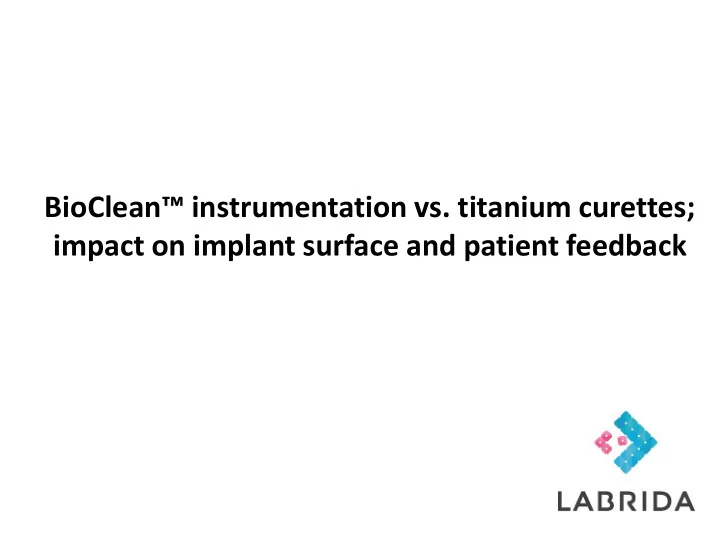

BioClean™ instrumentation vs. titanium curettes; impact on implant surface and patient feedback
Part I SEM analysis of titanium implant surfaces after instrumentation with BioClean™ or titanium curette
Materials and Methods Three titanium implant surfaces (smooth, machined, rough) were either left untreated or instrumented 30 sec. with a titanium curette or a BioClean™ chitosan instrument (Labrida AS). The surfaces were then analyzed by SEM for changes in structure.
Smooth Machined Moderately Rough (TiOblast) Control 1 2 3 Titanium curette 4 5 6 BioClean™ 7 8 9
SEM 250X Smooth/Ctrl Machined/Ctrl Rough/Ctrl Smooth/Curette Machined/Curette Rough/Curette Smooth/BioClean™ Machined/BioClean™ Rough/BioClean™
SEM 1000X Smooth/Ctrl Machined/Ctrl Rough/Ctrl Smooth/Curette Machined/Curette Rough/Curette Smooth/BioClean™ Machined/BioClean™ Rough/BioClean™
Conclusion I Titanium curettes have a significant impact (seen as grooves and flattening) on all implant surfaces tested (yellow arrows). The BioClean™ instrument did not cause any detectable change in the implant surfaces, but chitosan fiber remnants were observed in the rough surface (green arrow). The bioactive chitosan remnants reduce inflammation and bacterial regrowth after debridement, and is totally resorbed within days after the procedure.
Part II Patient feedback after debridement procedure 12 patients participating in a randomized split mouth, case control clinical study on treatment of peri-implant mucositis with either titanium curettes or BioClean™ instruments were included in this trial. Patients were asked to report pain and discomfort on a modified VAS scale (0-10) after 2 minutes of treatment. No local anesthesia was administered.
Mean discomfort (VAS) Curettes: 4,8 Mean discomfort (VAS) BioClean™: 2,9. P = 0,017
Conclusion II Implant debridement in patients treated for peri-implant mucositis is often associated with discomfort and pain. The use of titanium curettes cause significantly more reported discomfort (p = 0,017) than when the procedure is carried out with the BioClean™ instrument. The trial compared the situation after two minutes of treatment for both types of instruments. It should therefore also be taken into consideration that BioClean™ debridement is significantly faster than curettes, reducing the instrumentation time to less than half of what is needed when using hand-held instruments.
Recommend
More recommend